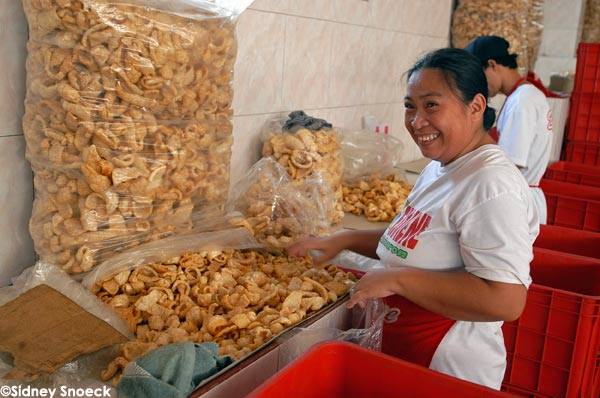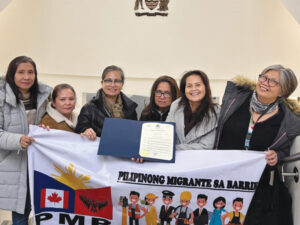Four days before Valentine’s Day, the town of Santa Maria in Bulacan celebrates the Chicharon Festival. It is a special day indeed that celebrates a very popular and delicious Filipino snack that sometimes results in heart burn and high blood pressure if consumed in large quantities.
The manufacturers of chicharon (pork rind crackling) in this first-class urban town are given a well-deserved day of recognition during the annual Chicharon Festival that is held every February 10th. The local government of Santa Maria holds the festival in line with the celebration of the feast of the municipality’s patron, the Immaculate Concepcion.
During the Chicharon Festival, the makers of chicharon present their product in different stylish ways and in different sizes and shapes. Those who are creative even put on costumes and floats to show off their chicharon in the traditional parade held around Santa Maria. The festivities also held a cooking festival for college students who came up with several new recipes that made good use of chicharon, like chicharon steak.
Santa Maria is a first-class urban municipality located 32 kilometers northeast of Manila. It gets at least a tenth of its income from crackled pork skins that remain a favorite snack of Filipinos. It has a booming agri-based industry that focuses more on poultry and raising pigs with more than 150 poultry and piggery farms scattered around the municipality. The swine farms are the main source of pigs whose skins become the pork rind cracklings that many Filipinos love to consume.
Fortune Lorenzo, municipal planning and development officer of Santa Maria, said the booming chicharon industry is composed of more than 20 chicharon manufacturers and they have given the town an unprecedented economic boom for several years.
“This need for chicharon has made Santa Maria into a popular tourist destination, attracting people from around the country who are curious and want a taste of the town’s most famous product,” said Marina Concepcion, municipal tourism officer of Santa Maria. She also added that the chicharon industry and the tradition of making chicharon, was inherited from our grandparents.
According to Jimmy Corpuz, the ex-officio chair of the Bulacan Heritage Conservation Society, the beginnings or origins of the local chicharon industry of Santa Maria can be traced back to Pacencia de la Torre-Tuazon. She is said to have started the town’s chicharon industry as a backyard trade when she decided to make use of leftover portions of a butchered pig instead of throwing it away. Santa Maria’s chicharon industry started from humble beginnings in the 1900s, mostly from backyard piggeries and swine raisers.
Corpuz proudly said that the Santa Maria chicharon is billed as a Bulacan brand at par with the popular sisig of Pampanga. The producers of chicharon have their own secret preparations or recipes for making chicharon but others have been importing pork skin from foreign countries like Spain, Australia, the United States and Canada.
Reynaldo Buenviaje, the owner of Daboy Chicharon, said the demand for chicharon today is very high and because Filipinos can’t get enough of it and keep on consuming a lot of chicharon, he sometimes has a supply problem with pork skin. Hence, the importation of pork skin from other countries. After taking lessons on how to make chicharon from his aunt, Buenviaje decided to put up his own chicharon business in 2002.
Jennifer Torres, the owner of Jenny’s Chicharon, said she and her husband started their chicharon business in 1986 and their brand became more popular and in demand when they introduced microwavable chicharon packs to the market.
Did you know that there are many different kinds of chicharon in the Philippines? Chicharon with laman is pork rind that has the meat still attached to it. Laman is the Tagalog word for flesh or meat.
Chicharon with special laman uses pork loin with fat and much thicker meat. Chicharon cocktail is just pork skin without the fat attached to it. Chicharon bilog is pork belly skin while chicharon bituka is deep fried large intestines of the pig. Bituka is the Tagalog word for intestines.
Chicharon bulaklak is pork intestine railings that are thoroughly cleaned, blanched and cooked. Chicharon bits are chicharon without fat or meat. The size and shape of chicharon bits is similar to popcorn.
Ground chicharon is crushed pieces of chicharon which is ready to be mixed into classic Filipino dishes like ginisang munggo, ginisang mixed vegetables, binagoongan, lugaw (porridge) and pinakbet. Ground chicharon is also used as a topping for noodle dishes like pancit palabok, pancit Malabon and La Paz batchoy.
Since there are these types of chicharon referring to different parts of the pig’s body other than the skin, what will you call the original chicharon that’s the pork rind, like with the actual skin? That would be chicharon balat. The Tagalog word for skin is balat. The name chicharon is sometime spelled tsitsaron and even as sitsaron in classic Tagalog orthography.








